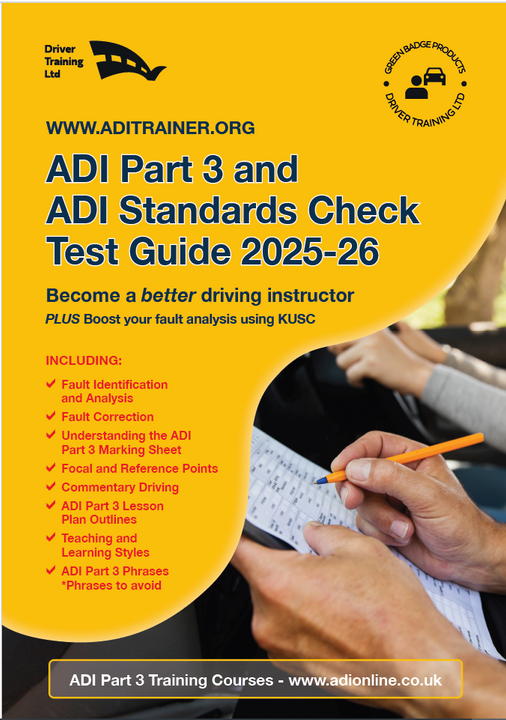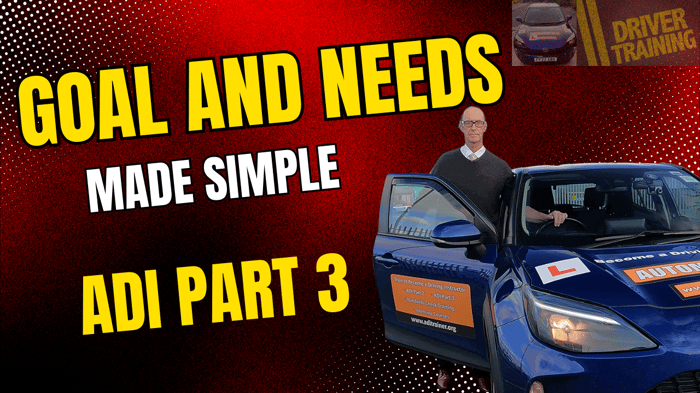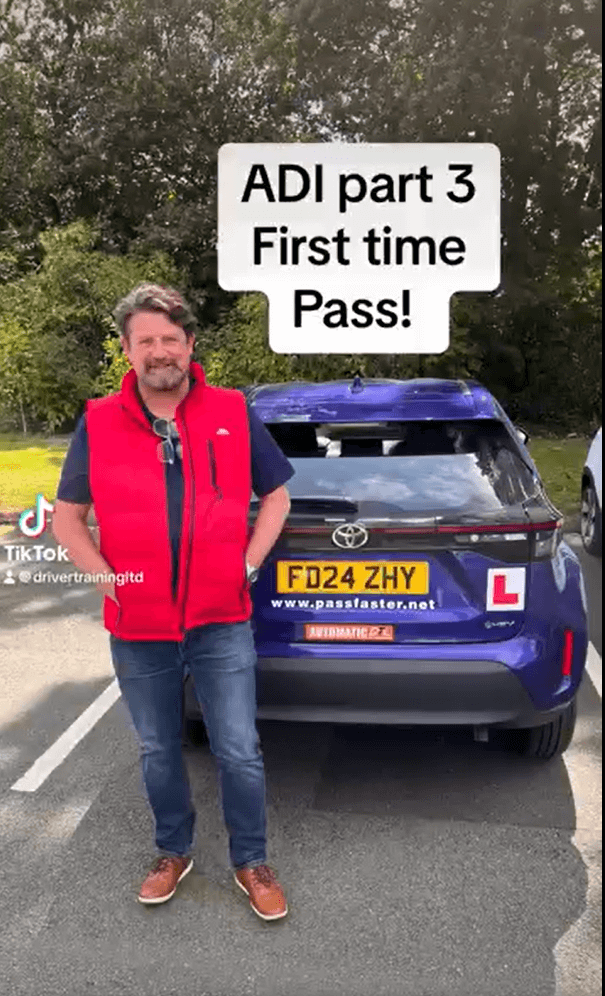Did the Trainer Identify the Pupil’s Learning Goals and Needs?
Table of Contents
Did the Trainer Identify the Pupil’s Learning Goals and Needs?
Did the Trainer Identify the Pupil's Learning Goals and Needs?
When you’re training to become a driving instructor, one of the most important questions you’ll face in your ADI Part 3 test is:
Did you clearly identify what your pupil needed to learn today?
This isn’t just a box-ticking exercise for the examiner. It’s the foundation of every effective driving lesson. If you don’t know where the pupil is starting from, and you don’t set a clear destination, the rest of the journey can feel muddled and unproductive.
Your job is to state today’s lesson goal clearly and simply, based on what the pupil has already done and where they need to improve.
Did the Trainer Identify the Pupil’s Learning Goals and Needs? Why This Matters
When you think back to your own learning, whether that was driving or any other skill, you’ll remember how frustrating it felt when you weren’t sure what the lesson was supposed to achieve. A good instructor doesn’t just “go for a drive” and hope things improve. They set out a plan.
For your Part 3 test, examiners want to see you do the same.
The Goal = the bigger picture. This is what the pupil should be able to do more confidently or safely by the end of the lesson.
The Need = the specific focus. This is the area that will help them achieve that goal, usually drawn from something they struggled with in a previous lesson.
When you link the goal and the need together, you create a lesson that makes sense to the pupil, to the examiner, and to you as the trainer.
Did the Trainer Identify the Pupil’s Learning Goals and Needs? A Real Example
Imagine your pupil nearly drove across a pedestrian crossing with someone on it in the last lesson. You had to step in with the brake. Clearly, this is an area that needs immediate attention.
Today’s Goal: Become better at dealing with pedestrian crossings.
Today’s Need: Learn the differences between the crossings and practise looking for pedestrians who are approaching or already crossing.
Now you’ve given your pupil a clear focus. They know why today’s lesson matters, and they can measure their progress against that specific challenge.
The Difference Between a Good Lesson and a Great Lesson
A good lesson is one where the pupil gets some practice.
A great lesson is one where the pupil knows what they’re practising and why.
That’s the heart of this Part 3 competency. It’s not about fancy words or overcomplicating things. It’s about showing that you can connect yesterday’s mistakes to today’s progress.
For example:
If your pupil struggled with roundabouts, today’s lesson might focus on entering safely and judging gaps.
If your pupil forgot to check mirrors before signalling, today’s lesson might focus on the MSPSL routine and why each step matters.
If your pupil lacked confidence on hills, today’s lesson might be about hill starts and clutch control.
Each one is a small step on the road to becoming a safe driver.
What Examiners Are Looking For
The DVSA examiners don’t want you to deliver a scripted, robotic line at the start of every lesson. They’re looking for a natural conversation that shows you’ve understood your pupil.
Here’s what they want to see:
✅ Did you talk to the pupil about their previous driving?
✅ Did you identify something specific that needs improvement?
✅ Did you clearly set today’s lesson goal?
✅ Did you make sure the pupil understood and agreed?
That’s it. No jargon, no long speeches — just a clear link between past performance and today’s focus.
Did the Trainer Identify the Pupil’s Learning Goals and Needs? Making It Pupil-Centred
Remember, this isn’t about you giving a lecture. It’s about drawing the information from the pupil. Ask questions like:
“How did you feel about pedestrian crossings last time?”
“What do you think went wrong when we approached that zebra crossing?”
“What would you like to get better at today?”
By asking, listening, and guiding, you’re making the lesson about their progress, not just your plan.
This is what examiners mean by “client-centred learning” — and it starts with identifying goals and needs.
Building a Structured Lesson
Once the goal and need are clear, the rest of the lesson naturally flows:
Set the scene. Remind the pupil of what happened before and why today’s goal matters.
Agree on the focus. Make sure they understand the need and are on board.
Practise in stages. Break the goal down into manageable chunks, starting in easier conditions and building up.
Review progress. Keep checking back — are they meeting the goal? Have the needs been addressed?
By the end of the drive, both you and the pupil should be able to say: “Yes, I can see the improvement.”
ADI Part 3 Marking Sheet Explained - Online Course

£4.95
ADI Part 3 Marking Sheet Explained - Online Course ADI Part 3 marking sheet explained "The ADI Part 3 marking sheet explained course - This isn’t just another course full of theory questions with no context. You're going to get:… read more
Common Pitfalls to Avoid
Trainee instructors often fall into the same traps:
Being too vague. Saying “We’ll work on general awareness” isn’t enough. Be specific: “We’ll focus on checking mirrors before signalling.”
Ignoring the past. Don’t just set a random topic. Always link today’s goal to what happened last time.
Doing too much. Stick to one clear goal and need. If you overload the lesson, nothing gets learned properly.
Not checking understanding. Make sure the pupil can repeat back today’s focus in their own words.
Avoid these mistakes, and your lessons will feel sharper and more effective.
Why This Competency Matters in Real Life
It’s easy to think of Part 3 as just “passing the test,” but this competency has real-life importance. A driving lesson without a clear goal is like a journey without a map. The pupil may cover miles, but they won’t arrive anywhere useful.
By identifying goals and needs, you:
Make the lesson meaningful.
Build pupil confidence.
Show professionalism.
Prove to the examiner that you’re in control of the learning process.
This is the mark of a true instructor, not just a driver who happens to be sitting in the passenger seat.
Did the Trainer Identify the Pupil’s Learning Goals and Needs? - The Bigger Picture
Remember, the ultimate goal of every lesson isn’t just to pass the driving test. It’s to prepare pupils for safe, independent driving for life.
When you identify goals and needs, you’re teaching them how to reflect, how to spot their own weaknesses, and how to improve step by step. That’s a skill that will stay with them long after they’ve got their pink licence.
Did the Trainer Identify the Pupil’s Learning Goals and Needs?
Your role in this competency boils down to three simple steps:
Look back at what the pupil did before.
Spot what needs work — the specific thing that caused a problem.
Set today’s clear goal and need so the pupil knows what to focus on.
Do this consistently, and not only will you pass Part 3, but you’ll also build a reputation as an instructor who delivers structured, effective, and pupil-centred lessons.
Final Word of Encouragement
Every great instructor once stood where you are now — nervously preparing for Part 3, wondering if they’d ever get it right. The truth is, it’s not about perfection. It’s about clarity, structure, and care.
When you start each lesson by identifying the pupil’s goals and needs, you’re laying the foundation for success. You’re proving that you can guide a learner step by step, with patience and purpose.
Remember: a good lesson gets the pupil driving, but a great lesson gets the pupil learning. And that starts with one simple question:
“What’s today’s goal, and what do we need to work on to achieve it?”

.jpeg)

